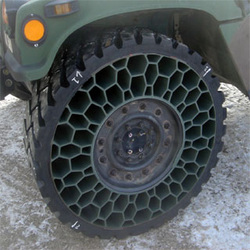
Airless Tire Promises Grace Under Pressure for Soldiers [Slide Show]
The Pentagon investigates the use of a new type of airless tire designed to get troop-carrying Humvees through hot spots without stopping
By Larry Greenemeier | August 11, 2008 | 6
NON-PNEUMATIC TIRE: The Wausau, Wisc., National Guard is testing a set of Resilient Technologies's 37-inch (94-centimeter) NPTs on one of its Humvees. Image: Courtesy of Resilient Technologies, LLC
In Iraq and elsewhere, improvised explosive devices (IEDs) pack a double-deadly whammy: They can kill when they explode, and then they turn surviving soldiers into sitting ducks when Humvee tires blow out. Conventional Humvee tires need a certain amount of air pressure, but also may include so-called "run-flat" inserts that wrap around the tire's rim to keep it from going completely flat when the tire's surface is ruptured. The U.S. Army, however, is looking for an alternative that can keep its vehicles running faster and farther than a run-flat donut after an attack.
To keep troops from being stranded and easily ambushed on the battlefield, the Army is working with researchers to develop tires for their Humvees that can better withstand roadside attacks. One such design comes from Resilient Technologies, LLC, based in Wausau, Wisc., and the University of Wisconsin–Madison's Polymer Engineering Center. With a four-year, $18-million grant from the Pentagon, Resilient is working to create a "non-pneumatic tire" (NPT) technology, called that because it doesn't require air.
The NPT looks like a circle of honeycombs bordered by a thick black tread. "There's a lot of space for shrapnel to pass through," says Ed Hall, Resilient Technologies's director of business affairs. "Even if you remove 30 percent of the webs, the tire will still work."
Resilient is now working to deliver to the Army Research Lab a prototype wheel that the Army would be able to manufacture on its own. "The Army Research Lab approached us, saying that flats on Humvees made them susceptible to attack," Hall says. "We looked at a lot of non-pneumatic designs before coming up with a polymeric web."
Resilient says it's too early to say how much the tires will cost or even which polymers they're using, because they're still in the prototype phase. (The company installed a set of 37-inch (94-centimeter) NPTs on a Wausau-based National Guard Humvee to test them in April.) Although the military is hoping to put these tires in use as soon as possible, Resilient has no plans for a consumer version right now. It may be a decade or more before an NPT makes spare tires a relic of the past: that's how long Michelin says it will be before its airless "Tweel" comes to market. In the meantime, the Tweel is more likely to show up on small construction vehicles.
And for those of you wondering why all tires aren't simply made out of solid rubber, some construction vehicles use them on sites with debris that can easily shred a pneumatic tire, but solid tires give an incredibly rough ride, generate a lot of heat, and might be even worse if a piece came off during an explosion, because it could not easily be repaired. The NPT's honeycomb structure is designed to support the load placed on the tire, dissipate heat and offset some of these issues.
View a slide show of Resilient's technology
 RSS Feed
RSS Feed
